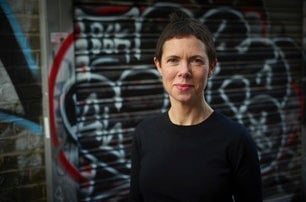A social activist’s radical plan to use human relationships to fix the broken economy
Ella has never had a job in her life. As a child, she was abused and neglected. As a mother, she struggles: one son drinks and often disappears, another is violent with her and her neighbors, and one daughter is pregnant at 16. At one point, more than 70 professionals and 20 departments in Swindon, the British city where she lives, were involved in her life, at a cost of £250,000 ($327,000) a year to taxpayers. She described her life as hell.


Ella has never had a job in her life. As a child, she was abused and neglected. As a mother, she struggles: one son drinks and often disappears, another is violent with her and her neighbors, and one daughter is pregnant at 16. At one point, more than 70 professionals and 20 departments in Swindon, the British city where she lives, were involved in her life, at a cost of £250,000 ($327,000) a year to taxpayers. She described her life as hell.
When Hilary Cottam, a social activist, mapped out how one of those social workers spent his time with families like Ella’s, she found that 86% was on administration and gate-keeping, while 14% was used trying to help the family. When Cottam gathered these overworked, fraught front-line workers and asked for an example of a case like Ella’s that now no longer required the government’s support, not a single hand went up.
Cottam set out to flip the ratio of administration and assistance, and work with a small group of officials to help build Ella’s abilities, confidence, and networks, to try and achieve the life Ella wanted. The goal was not to “fix” her, but mobilize people to help her in more meaningful, less box-ticking ways. Ella picked her team of social workers and police, who agreed to try working in a new way. They started by asking Ella what kind of life she wanted: it was an office job, it turned out. With a goal, and support, Ella started to build a better life, free of constant eviction notices, with her kids back in school, and, an IT training course.
Over a decade, Cottam has tried to put people on the margins of society at the center of their own stories, architects of their futures rather than recipients of faceless, often ineffective benefits. She’s worked “cradle to grave”: with families like Ella’s, the elderly, the chronically ill, teens, and those out of work. Rather than try to fix outdated institutions, her team starts by asking, “What are you doing? What do you need? What do we need to flourish? How can we build that?” she said.
Some of these efforts were more successful than others—they were experiments, after all—but each of them created human capability, not just for the “recipients” but for all of the participants; those who needed help and those who wanted to help. Our problems are relational and individual; our solutions have to incorporate both.

Cottam, who describes her work in the book Radical Help: How we can Remake the Relationships Between Us and Revolutionise the Welfare State, believes that there is a great desire to fix our communities and ourselves. It cannot be achieved by bureaucracy alone, but through each other. “People change so fast when you recognize them, when you recognize their dreams,” she says.
Indeed, while she suspected human relationships were important, a decade of experiments and data convinced her even more. Relationships, she says, “are everything.”
How we got here
In 1942, in the wake of two world wars, Sir William Beveridge created the template for the modern welfare state in Britain, laying out policies for full employment, a national health service, family allowances, and social insurance to combat poverty. When he published his report, half a million copies were sold within three days and the first edition sold out in a matter of weeks. “The nation’s health improved, life spans lengthened, there was access to good education and security for those who were temporarily out of work,” Cottam writes in Radical Help.
Those systems, while revolutionary in the 1940s, are now outdated. They were designed for workers in an industrial model for jobs; the NHS was created to deal with infectious disease, not chronic health conditions; welfare was created as a stopgap solution, not a way to support structurally underpaid work. Nearly half of all working families in Britain are now supported by benefits, Cottam writes, as the welfare state subsidizes the private sector’s unwillingness to pay a living wage.
These systems are not designed to deal with 21st-century problems: climate change, chronic disease, a rapidly aging population, gig work, and families with multiple layers of challenges like Ella’s. Nor are they meant to deal with modern poverty, which includes in-work poverty. “Modern poverty is as much about who we know, our relationships, as it is about money,” Cottam says.
Cottam’s team developed a set principles to guide the support of people to help them thrive. They shift a model that tries to fix a problem and manage needs (Ella’s, a lonely 90-year-old, someone who is chronically ill) to one that builds capabilities and carves a path to a “good life”; from one that is transactional to one that is “above all, about relationships”; from one that is about auditing, containing risk, and targeting to one that connects multiple resources and funding and focuses on creating possibility. They rely on technology to connect people to each other. “We need a social revolution to match the technology revolution,” Cottam has written.
What to do about it
Take her work on employment. Today, 80% of people got their last job from a contact, which makes it easy to find work for the well-connected and nearly impossible for people with weaker networks.
Cottam and her team created Backr, starting in south London by building networks of not just the unemployed, but of people who can help each other. She set up shop in a job center which, she notes, look remarkably similar to the ones first opened in the 1940s (long lines, little hope). They fail more than they succeed: two-thirds of seekers fail to find jobs in a process that is dehumanizing.
Cottam and her team asked people to pay £5 to join a team that promised to do things differently. They started by building relationships and trust. They did not ask about how long someone had been out of work or about their qualifications, but about their dreams and who they needed to connect with to make those dreams happen. (She once described the sessions as a cross between AA and speed dating.) Then, she and her team started knocking on doors, asking who would be willing to help with it. Who could help build skills and expand connections? People wanted to help. “We’ve never had a problem with people participating,” she says.
They used basic technology—mobile platforms, cheap databases—to build the back end to make sure the focus stayed on people, not administration. PwC evaluated Backr in a randomized control trial, and found that it cost one-fifth of other programs at the time: 87% of members found work or progressed, compared with the 66% failure rates of standard job center approaches, and 54% of the long-term unemployed found work.
She is careful to point out that technology is the enabler, not the fix itself. “This is not LinkedIn for the unlinked,” she says. “It is using technology to bring people together to make real human connections.”
Circles is another program, designed for the elderly, which lets men like Stan, who lives alone and has mobility issues, listen to music on the phone with others who love music, or to get help with a ride or getting some groceries, and allows Stan to help others. Wellogram, meanwhile, brought chronically ill people together to set goals and help each other stick to them. Three-quarters of the smokers in Wellogram successfully quit, 44% lowered their blood pressure, and 64% started work or went back to school. These approaches are less top down, and more side-by-side in nature.
What happens next
Cottam works two ways: first, by living with the people she is studying (she and her team moved into the housing estate near Ella to actually understand her life); and second, by creating solutions that mobilize people outside traditional services, like Backr.
The obvious question is, of course, how to scale the work. She does not believe in industrial scaling, but in planting ideas to take root and grow their own way: “I don’t want to be Prada, I want to be Primark,” she says, citing a ubiquitous British retailer. For example, local councils like the one in Wigan, in Greater Manchester, have rebuilt their social services (pdf) with the principles of radical help pioneered by Cottam.
But efforts like hers, and others, remain marginal. They cannot access funding, and they don’t fit traditional measurement frameworks, which are often flawed and backward-looking. Participle, an organization she formed to run experiments of alternative social services, shut down a few years ago after building six new services, engaging 12,000 people and fostering well over 100,000 social connections.
While the ideas they fought for—human-centered, social design—have become more mainstream, the funding has not been forthcoming. Even after she proved her low-cost Backr model with trials of 2,000 people, there was no series B funding behind it.
Beveridge, it turns out, wrote three reports when founding the modern welfare state. In the third, which was not well-read, he expressed regret that he had made a terrible mistake, leaving people—relationships and communities—out of the system, which was hampering innovation, and support for each other to change. “People need human connection to make change, and most of all to sustain change,” Cottam says. The goal is building ways to foster the connection.
Cottam is now focused on defining good work, “how we create it and what we need to underpin it” (there’s a manifesto (pdf) here). She’s is both optimistic and pessimistic about the future. “We are building strong local networks and they are transforming lives,” she says. “And there’s a meta-narrative of the rise of the far right, of hatred.”
What she knows for sure is that people who have been part of the programs her teams have created have been transformed. “You have been dipped in something,” she says. “If we thought about everything through the lens of relationships it would change what we invest in so fast.”